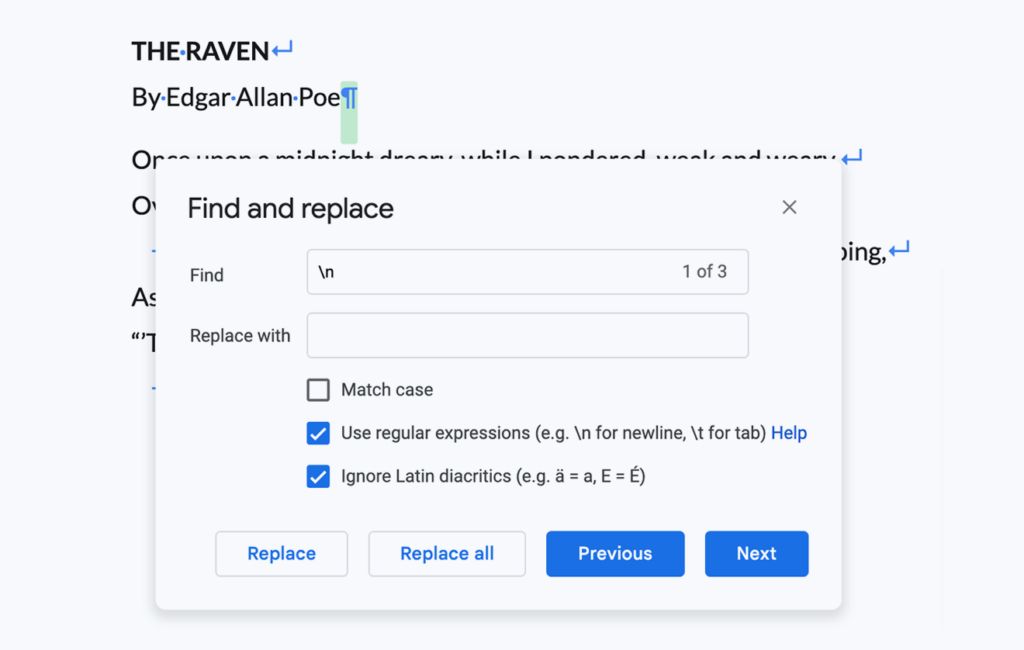

If you spend a lot of time in Google Docs, you might be familiar with the concept of a "hard" or "soft" return – they're just two different ways to create line breaks that behave in distinct ways. Understanding the the differences between the two can help you create documents that are both visually appealing and easy to read. Here, we'll teach you how to create a hard or soft break in Google Docs; then, we'll show you how to identify them using simple keyboard shortcuts and regex search tricks.
Hard Returns
A hard return adds a line break that starts a new paragraph, creating a clear separation between different sections of your document. You can create a hard return by pressing the Enter key on your keyboard. Here, a hard return creates a new paragraph, complete with additional spacing between the two blocks of text:
 A hard return is represented in Google Docs by the formatting mark ¶. By default, these formatting marks are not visible, but you can toggle them on and off by navigating to View > Show > Non-Printing Characters in the Google Docs toolbar.
A hard return is represented in Google Docs by the formatting mark ¶. By default, these formatting marks are not visible, but you can toggle them on and off by navigating to View > Show > Non-Printing Characters in the Google Docs toolbar.
Soft Returns
A soft return, on the other hand, allows you to add a line break without starting a new paragraph. You can create a soft return by pressing Shift + Enter on your keyboard. Here, a soft return adds a new line, maintaining line spacing consistent with text within the same paragraph: In Google Docs, a soft return is represented by the symbol ↵. Again, you can see these by navigating to View > Show > Non-Printing Characters.
In Google Docs, a soft return is represented by the symbol ↵. Again, you can see these by navigating to View > Show > Non-Printing Characters.
Considerations for Using Soft Returns
So, why would you ever use a soft return instead of a hard return? The simple answer is that they're very useful for custom formatting. A hard return limits you to creating a new paragraph every time you want to start a new line; a soft return allows you to create multi-line blocks of text, which is useful for formatting lists, addresses, footnotes and even poetry.
For example, let's say you want to create a bulleted list with formatted line breaks within the individual list items. If you just hit Enter to create your line breaks, you'll end up creating a new bullet point every single time:
 But if you press
But if you press Shift + Enter to create a soft return within a list item, you have more control over the formatting of your list:

Here's the thing about soft returns – they're indispensable for bespoke formatting in documents that will stay in Google Docs, but they can cause serious issues when exported. Soft returns aren't recognized by all programs and seem particularly prone to being chewed up and mangled in the process of exporting text from Docs. If you've ever copied and pasted a block of text from one program to another and been baffled by the sudden appearance or disappearance of seemingly-random line breaks in your text, confusion over custom formatting is probably to blame.
For Drive Connect users, it's particularly worth noting that soft returns have the potential to cause unexpected issues in merge templates. If you use a soft return within a merge field, the line break won't appear in your generated document if the field is empty. To make sure that your line break appears whether or not the field you're referencing is empty, you'll need to create a definitive break by adding a hard return.
Identifying Hard & Soft Returns
If you're having issues with line breaks in your document, the first thing you'll want to do is see where they are and which kind of break you're dealing with. As we mentioned earlier, you can navigate to View > Show > Non-Printing Characters to see the symbols that represent hard and soft returns. You can also toggle the visibility of these formatting characters on and off using keyboard shortcuts. Depending on your operating system, the shortcut you use will differ:
- Windows:
Ctrl+Shift+8 - Mac:
Cmd+Shift+8
Remember, hard returns are represented by the symbol ¶, while soft returns are represented by the symbol ↵.

You can also quickly identify line breaks with the Find and Replace tool in Google Docs. To do this, navigate to Edit > Find and Replace and tick the Use regular expressions checkbox. To find hard returns, you'll need to search for the syntax reference \n; to find soft returns, search for \v.

It's worth noting that, for whatever cursed reason, this only works for finding hard and soft returns – it doesn't work for replacing a hard return with a soft return or vice versa. To do that, you'll need to download an advanced Find & Replace plugin for Google Docs (or, as one embittered user in this help thread suggests, do it in Microsoft Word instead).
Interested in more Google Workspace tips and tricks? Check out our blog archive for more Google Workspace tips and tricks, and follow us on LinkedIn to stay up to date with our latest posts.
And if you're interested in Google Workspace and Salesforce, you're going to want to get familiar with Drive Connect, our complete solution for integrating the two workflows. Try it for free for two weeks – no credit card required.
Integrate Salesforce with Google Drive in Minutes
Try it for free for 14 days – no credit card required.
